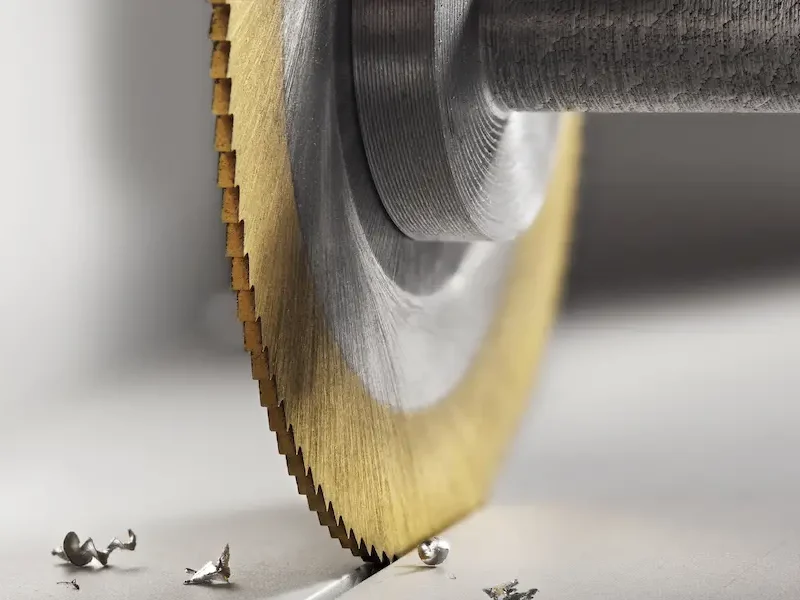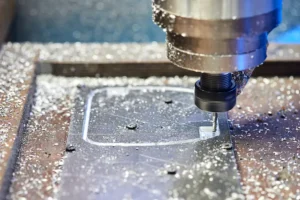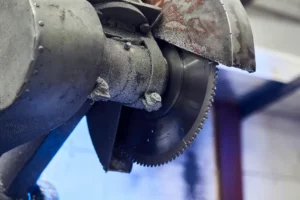
Profile milling is a type of machining that uses rotating milling cutters to remove material from a workpiece in order to create the desired finish on a vertical or slanted surface. The technique can be operated on a variety of materials, including metals, plastics, and composites. Profile milling can be performed using a variety of different tools, depending on the chosen outcome. In this guide, we will cover the basics of profile milling, including the process types, tools, and common applications.
Table of Contents
Profile Milling Process

Profile milling is the operation of machining intricate three-dimensional surfaces on a workpiece. It can be used to create features such as slots, pockets, and contours. The milling is performed by a multi-axis milling machine, which rotates a milling cutter around the workpiece. The cutter follows the tool path and removes material from the workpiece as it moves.
There are three types of profile milling operations:
Roughing is intended to produce the largest possible part dimensions with a reasonable number of passes. Roughing operations are typically required for reducing the thickness of stock in large enough sections to remove excess material from inside or outside of the part. Holes on the face of the workpiece require an end mill that cuts on the periphery, the side of the cutter. The mill that is used in this type of operation is called a “peripheral end mill.”
Semi-finishing
Semi-finishing machines use center-cutting tools to cut the parts where the hole will be located. Once the location of the holes is known, the semi-finishing tools cut the part around the hole.
Finishing
Finishing end mills are very small and are used to reduce the amount of material removed in a roughing process, making way for the finishing operations. They are typically much smaller than the tools used in roughing operations and often have a chamfer on one side or both sides of the cutting edge. It is suggested to conduct roughing and finishing in different machines and to use an optimized cutting tool for each operation to achieve more precise results.
Profile Milling Tools Choice
There are a few different types of devices that can be used for profile milling, and the best choice depends on the type of milling operation, the material being milled, and the desired finish. For example, end mills and ball nose cutters are typically used for softer materials, while carbide or a diamond-tipped tool is better suited for the harder ones.
Generally, round inserts and concepts with a radius are the cutters used for roughing and semi-roughing. While ball nose end mill and concept with a radius are better suited for super-finishing.
Steps of a Successful Profile Milling

To achieve a successful profile, there are a few key steps that must be followed:
- Select the appropriate tool for the material being machined.
- Rough the surface with a diamond saw to determine if the surface is too hard for abrasive cutters or too soft for end mills.
- Set the depth of cut according to the properties of the workpiece to reduce vibrations.
- Fix the profile in accordance with the desired cut direction and depth of cut, and then mill along the profile. The end mill may then be removed.
- After the desired cut is made and the job is finished, a cutting cycle may be completed by returning the spindle to the previous cutting orientation.
Tips on How to Optimize your Profile Milling Operations
Profile milling is an essential process for many manufacturers. It is a versatile machining procedure that can produce complex shapes and features on a variety of materials. In order to optimize your profile milling operations, there are a few things you should keep in mind.
First, select the appropriate tool for the material you are machining because the wrong tool can cause the workpiece to be damaged or deformed. The most important things to consider when selecting the right tool are the material and geometry of the workpiece. For example, when drilling into concrete, the correct tool would be a rotary hammer with a carbide-tipped drill bit. The material is important because it affects the speed and feed rate of the tool. It is also noteworthy because it affects the type of tool that is needed.
Second, use the proper cutting speed and feed rate for the material and tool. It’s what determines how fast the cutter will rotate and how fast it will move along the workpiece. The faster the cutter rotates, the more material it can remove. And the faster it moves along the workpiece, the more accurately it can cut the desired shape.
An additional thing to keep in mind is that the cutting speed should be less than the maximum allowable speed for the machine tool. At speeds above this, the tool may become difficult to control as it tends to walk along the workpiece. As a result, the cutter may “flog” or bump over long distances. This can cause chipping or tear-out of the material and can cause damaging vibrations to other parts of the machine.
Finally, make sure to use the correct cutting fluid to minimize heat and wear on the tool. Cutting fluids help to cool and lubricate the cutting tool and workpiece. This helps to improve tool life and surface finish. The correct cutting fluid can also reduce the risk of welds.
The Takeaway
Profile milling is a machining process used to create complex shapes in a variety of materials. There are various types of profile milling processes, each with its own advantages and disadvantages. The type of process used will depend on the desired shape, the material being machined, and the tolerances required. The key to successful profile milling is careful tool selection and process planning. The article serves as a guide to the ins and outs of profile milling, covering the common process types, the importance of tools selection, and a checklist for a successful milling process.
